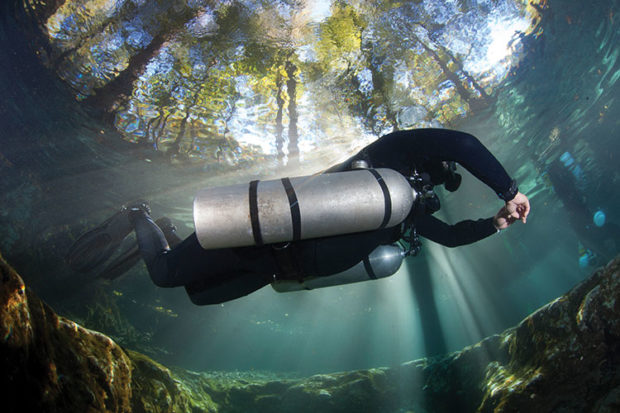Primary Sidemount Skills
By Steve Lewis

If you have aspirations of moving your scuba diving into the world of sidemount diving this article might interest you. If you are a bona fide sidemount diver and especially if you’re going a little deeper, planning exposure that require staged decompression, use exotic breathing gases (and lots of it), or perhaps if you’re diving in hard overhead environments like caves and wrecks, PLEASE read this.
The switch to sidemount seems epic from where I’m standing. The traditional North Florida Cave Kit – back-mounted doubles, long hose, manifold, backplate, and wing – still has its followers and remains a staple for the technical diving community, but the option of wearing your doubles pinned to your sides has caught up.
I don’t have statistics to share, so I can’t give you a percentage comparison, but judging by the number of sidemount diving groups on social media, and a quick tally of the diving photos on Instagram and Facebook, chances are that if you’re a technical diver, you have a sidemount rig in your scuba closet; or you’re thinking about getting one to hang in there.
That’s great. Welcome to the club.
Unfortunately, as with anything else that’s gone through a huge upswing in popularity, there’s a potential for key principles to get lost in the growth spurt. From yoga to coffee drinking, as consumer interest grows, the fundamentals tend to get diluted; that is human nature. We have to suck it up and accept that a drink made with non-fat coconut milk, injected with some sort of unpronounceable tropical fruit essence, and topped with whipped cream and party sprinkles is also coffee, although it’s a long sip from the traditional espresso we’d find in the early morning cafes in Spain, France, or Italy.
However, a liberal interpretation of the principles of mindfulness and the personal preferences in your daily caffeine consumption are unlikely to get you killed. Failing to understand the fundamentals of how to use a sidemount rig might. Or more likely, it might give you a nasty come-to-Jesus moment, which has its serious drawbacks too.
At this point, let’s skip the whole instant sidemount instructor prattle. Let’s just accept that there are men and women out there teaching something they call sidemount, but that really isn’t. Let’s just settle then on the statement that some principle skills are important, and whether or not you learned them is another debate and doesn’t detract from their importance.
Case in point: the basic shutdown drill.
Sidemount – as with so many technical diving skills – comes to the general diving population via cave divers; those crazy folk who swim around in holes in the ground, looking at wet rocks for hours. As a participant in something called Cave Camp – an annual social/teaching/learning event in Mexico’s beautiful cave country – I had the chance to watch and audit an instructor candidate demonstrate the classic “cave diver’s sidemount shut-down” to a student. It was truly neat to watch, especially when the student got it right. Progress.
I wondered to myself as I hung in the water above the two of them, how many certified sidemount divers outside of the cave community have learned it and have practiced it recently?
The steps are as follows:
- Check your SPGs and that both cylinder valves are fully open
- Signal “emergency” with your light
- Breathing from the right cylinder (the long hose), shut down the valve on that side while breathing from its regulator until the hose
is slack and empty - Switch to the backup regulator
- Clip the long-hose second stage to your harness and quieten your light signal
- Open the right cylinder valve
- Switch regulators (let your lefthand second stage drop on its necklace)
- Switch your light from your left hand to your right and signal “emergency”
- Shut down the left cylinder valve
- Purge the gas from the hose until it’s exhausted
- Quieten your light signal
- Open the left cylinder valve
- Check the gas is switched on and the secondary regulator is delivering gas
- Check both SPGs
- Signal OK to your buddy(ies)
There are minor variations to that sequence. One version has the diver breathing from the left-hand regulator as it’s shut down, switching to the long hose when the short hose reg is exhausted, and then re-opening up the left valve. Personally, I feel that in the overall picture, it’s way more important to be able to do the exercise with some level of facility than whether or not that detail is part of the deal or not.
So, as a sidemount diver, the question is: when was the last time you practiced this?
In the real world, it doesn’t matter whether our sidemount course covered this; it’s way more important that we understand its importance, its relevance regardless of whether we’re diving a cave or not, and to practice it!
I’d be interested to hear from you; to get your opinion about the value of this skill, and your journey in getting it right, especially if it’s new to you.
Oh, and it might be interesting for you to note that my RAID Cave Two student (and the instructor candidate) managed to demonstrate the whole shutdown sequence in perfect cave trim without moving in the water column more than four inches (10cm) up or down. Try it. It’s a fun thing to get right, and a heck of an achievement!
Steve Lewis is a technical instructor, cave IT, and coach. His latest book Death in Number Two Shaft is available on Amazon or, for signed copies, from the author at books@techdivertraining.org







